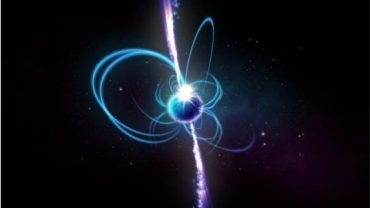
Artist’s impression of a magnetar. Credit: ICRAR
When a mysterious signal was found by an undergraduate student, Dr Natasha Hurley-Walker was perplexed. It was hiding in archival data from the Murchison Widefield Array (MWA), a large network of radio antennas in Western Australia. Based at the International Centre for Radio Astronomy Research, Natasha started to loop deeper. Repeating every 18 minutes, and initially found at only one frequency, the signal showed signs of being something astronomers have been searching for decades – radio transmissions from an intelligent species.
It’s not a much of a spoiler to say that it wasn’t aliens (it’s never aliens!), but repeating radio signals with this period hadn’t been seen before, and were very hard to explain at first.
This month, Natasha explains to Chris how the discovery unfolded, why it might have been aliens, why it wasn’t aliens, what else it couldn’t be, and what the current favourite theory is – something called a magnetar, but one which was behaving in a very unusual way.





